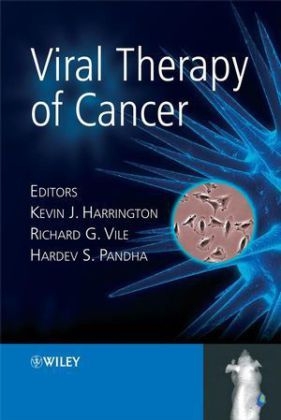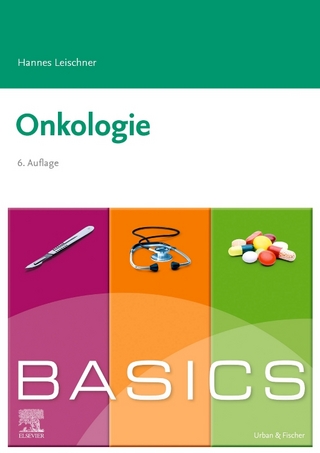
Viral Therapy of Cancer
Wiley-Blackwell (Verlag)
978-0-470-01922-1 (ISBN)
- Titel ist leider vergriffen;
keine Neuauflage - Artikel merken
Presents state of the art knowledge on how viruses can be, and have been, used in novel therapeutic approaches for the treatment of cancer* Describes the use of viruses as oncolytic agents, killing cells directly* Editors are experts in the field, with experience of both laboratory and clinical research Viral Therapy of Cancer is essential reading for both basic scientists and clinicians with an interest in viral therapy and gene therapy.
Dr K. J. Harrington, Targeted Therapy Laboratory, Cancer Research UK, Centre for Cell and Molecular Biology, Institute of Cancer Research, London, UK. Dr H. S. Pandha, Department of Medical Oncology, St. George's Hospital Medical School, London, UK. Professor R. G. Vile, Molecular Medicine Program,?Mayo Clinic, Rochester, USA.
Foreword. Preface. Contributors. 1. Adenoviruses (Kate Relph, Kevin J. Harrington, Alan Melcher and Hardev S. Pandha). 1.1 Introduction. 1.2 Viral structure and life cycle. 1.3 Adenoviral vectors. 1.4 Targeting adenoviral vectors. 1.5 Clinical applications of adenoviral gene therapy . 1.6 Adenoviral vectors for immunotherapy. 1.7 Adenoviral vectors for suicide gene therapy. 1.8 Adenoviral vectors for gene replacement therapy. 1.9 Oncolytic adenoviral therapy. 1.10 Adverse outcomes of adenoviral gene therapy. 1.11 Summary. References. 2. Application of HSV-1 Vectors to the treatment of cancer (Paola Grandi, Kiflai Bein, Costas G. Hadjipanayis, Darren Wolfe, Xandra O. Breakefield and Joseph C. Glorioso). 2.1 Introduction. 2.2 Basic biology of HSV. 2.3 Replication competent or oncolytic vectors. 2.4 Replication defective vectors. 2.5 Amplicons. 2.6 Impediments to the efficacy of HSV vectors for cancer gene therapy. 2.7 Strategies to enhance the efficacy and specificity of HSV vectors for cancer gene therapy. 2.8 Summary and conclusions. Acknowledgements. References. 3. Adeno-associated virus (Selvarangan Ponnazhagan). 3.1 Introduction. 3.2 Biology and life cycle of AAV. 3.3 AAV serotypes. 3.4 Production of recombinant AAV. 3.5 Gene therapy for cancer treatment. 3.6 Anti-oncogenic properties of AAV. 3.7 Molecular chemotherapy studies with rAAV. 3.8 AAV-mediated sustained transgene expression as a potential cancer gene therapy strategy. 3.9 rAAV vectors have advantages in stimulating T helper 1/cytotoxic T lymphocyte responses. 3.10 rAAV vectors can be used to initiate immune responses. 3.11 Altering AAV tropism for tumour-specific delivery. 3.12 Clinical trials involving rAAV. 3.13 Conclusion. Acknowledgements. References. 4. Retroviruses (Simon Chowdhury and Yasuhiro Ikeda). 4.1 Introduction. 4.2 Structure of retroviral particles. 4.3 Retroviral genome. 4.4 Retroviral life cycle. 4.5 Retroviral vectors. 4/6 Safety of retroviral vectors: insertional mutagenesis. 4.7 Gene therapy of X-linked SCID. 4.8 Retroviral cancer gene therapy. 4.9 Immunomodulatory approaches. 4.10 Conclusions. References. 5. Lentiviral vectors for cancer gene therapy (Antonia Follenzi and Elisa Vigna). 5.1 Development of Lentiviral vectors (LV). 5.2 Targeting of transgene expression. 5.3 Host immune responses to LV and their transgene. 5.4 Transgenesis. 5.5 Haematopoietic stem cell gene transfer. 5.6 Cancer treatment by LV. 5.7 Approved clinical trials using LV. 5.8 Conclusions. References. 6. Poxviruses as immunomodulatory cancer therapeutics (Kevin J. Harrington, Hardev S. Pandha and Richard G. Vile). 6.1 Introduction. 6.2 General features of poxvirus structure and biology. 6.3 Clinically applicable poxviruses. 6.4 Poxviruses as potential cancer therapeutics. 6.5 Clinical experience with poxviruses. 6.6 Conclusion. References. 7. Oncolytic herpes simplex viruses (Guy R. Simpson and Robert S. Coffin). 7.1 Introduction. 7.2 Herpes simplex virology. 7.3 Properties of HSV relevant to oncolytic virus therapy. 7.4 Mutations giving tumour-selective replication. 7.5 Oncolytic HSV expressing fusogenic membrane glycoproteins (FMG). 7.6 Prodrug activation therapy and oncolytic HSV. 7.7 Combination of oncolytic HSV with immunomodulatory gene expression. 7.8 Combination of conventional therapies with oncolytic HSV. 7.9 Summary. Acknowledgement. References. 8. Selective tumour cell cytotoxicity by reoviridae - preclinical evidence and clinical trial results (Laura Vidal, Matt Coffey and Johann de Bono). 8.1 Introduction. 8.2 Reovirus structure. 8.3 Reovirus replication. 8.4 Reovirus and human infection. 8.5 Oncolytic activitiy. 8.6 Mechanism of reovirus-induced cytotoxicity. 8.7 Preclinical experience. 8.8 Immunogeneicity. 8.9 Clinical experience. 8.10 Conclusions. References. 9. Oncolytic vaccinia (M. Firdos Ziauddin and David L. Bartlett). 9.1 Introduction. 9.2 Biology of vaccinia virus. 9.3 Tumour selectivity and antitumour effect. 9.4 Improving antitumour effects through bystander effects. 9.5 Immune response to vaccinia and vaccinia immune evasion strategies. 9.6 Virus-driven antitumour immune response. 9.7 Imaging. 9.8 Current and potential clinical applications. References. 10. Newcastle Disease virus: a promising vector for viral therapy of cancer (Volker Schirrmacher and Philippe Fournier). 10.1 Introduction. 10.2 Structure, taxonomy, pathogenicity and oncolytic properties of NDV. 10.3 Human application and safety. 10.4 Tumour-selective replication of NDV. 10.5 Virally based cancer immunotherapy and danger signals. 10.6 NDV: a danger signal inducing vector. 10.7 The human cancer vaccine ATV-NDV. 10.8 Pre-existing antitumour memory T cells from cancer patients and their activation by antitumour vaccination with ATV-NDV. 10.9 Clinical trials of antitumour vaccination with ATV-NDV. 10.10 NDV-specific recombinant bispecific antibodies to augment antitumour immune responses. 10.11 NDV-binding bispecific fusion proteins to improve cancer specific virus targeting. 10.12 Recombinant NDV as a new vector for vaccination and gene therapy. 10.13 Conclusion. References. 11. Vesicular stomatitis virus (John Bell, Kelly Parato and Harold Atkins). 11.1 Introduction. 11.2 VSV: genomic organization and life cycle. 11.3 Host range and pathogenesis of VSV infection. 11.4 Control of VSV infection by the innate type I interferon response. 11.5 Cancer cells are insensitive to type I interferon. 11.6 VSV preferentially replicates in and lyses tumour cells in vitro. 11.7 VSV attenuation: enhanced tumour selectivity and therapeutic index. 11.8 Engineered/recombinant VSV. 11.9 VSV effectively eradicates tumours in vivo. 11.10 VSV and the host immune response. 11.11 Host immunity vs. therapeutic efficacy. 11.12 VSV is a potent vaccine. 11.13 Innate sensing of VSV and the antitumour response. 11.14 So what is a good oncolytic virus? 11.15 Future challenges for VSV. References. 12. Measles as an oncolytic virus (Adele Fielding). 12.1 Introduction. 12.2 Measles virus and the consequences of natural infection. 12.3 MV vaccine. 12.4 MV genetics and engineering. 12.5 MV receptors. 12.6 Animal models for the study of MV pathogenesis and oncolysis. 12.7 Oncolytic activity of MV. 12.8 Mechanism of specificity. 12.9 Targeting MV entry. 12.10 Enhancing the oncolytic activity of MV. 12.11 Interactions with the immune system. 12.12 Potential specific toxicities of clinical use of replicating attenuated MV. 12.13 Clinical trials. 12.14 Conclusions. References. 13. Alphaviruses (Ryuya Yamanaka). 13.1 Introduction. 13.2 RNA viruses as gene expression vectors. 13.3 The biology of alphaviruses. 13.4 Heterologous gene expression using alphavirus vectors. 13.5 Cancer gene therapy strategies using alphavirus vectors. 13.6 Alphavirus vector development for gene therapy application. 13.7 Conclusions. References. 14. Tumour-suppressor gene therapy (Bingliang Fang and Jack A. Roth). 14.1 Tumour-suppressor genes. 14.2 Use of tumour-suppressing genes for cancer therapy. 14.3 Clinical trials of p53 gene replacement. 14.4 Tumour-suppressor gene therapy in multimodality anticancer treatment. 14.5 Future prospects. Acknowledgements. References. 15. RNA interference and dominant negative approaches (Charlotte Moss and Nick Lemoine). 15.1 Introduction. 15.2 Oligonucleotide agents. 15.3 Mechanism of RNAi. 15.4 RNAi and antisense compared. 15.5 siRNA design. 15.6 Off-target effects. 15.7 Induction of innate immunity. 15.8 Methods of delivery. 15.9 Antisense. 15.10 Dominant negative approaches. 15.11 Research applications of siRNA. 15.12 Therapeutic applications of siRNA. References. 16. Gene-directed enzyme prodrug therapy (Silke Schepelmann, Douglas Hedley, Lesley M. Ogilvie and Caroline J. Springer). 16.1 Introduction. 16.2 Enzyme-prodrug systems for GDEPT. 16.3 Gene delivery vectors for GDEPT. 16.4 Conclusions. References. 17. Immunomodulatory gene therapy (Denise Boulanger and Andrew Bateman). 17.1 Introduction. 17.2 Immunotherapy strategies using viral vectors. 17.3 Viruses used as viral vectors in cancer immunotherapy. 17.4 Clinical trials against specific TAA. 17.5 Conclusions and future prospects. References. 18. Antiangiogenic gene delivery (Anita T. Tandle and Steven K. Libutti). 18.1 Angiogenesis: role in tumour development and metastasis. 18.2 Targeting tumour vasculature as an approach for cancer treatment. 18.3 Viral vectors to deliver antiangiogenic gene products. 18.4 Viral targeting. 18.5 Concluding remarks. References. 19. Radiosensitization in viral gene therapy (Jula Veerapong, Kai A. Bickenbach and Ralph R. Weichselbaum). 19.1 Introduction. 19.2 Adenovirus. 19.3 Adeno-associated viruses. 19.4 Herpes simplex viruses. 19.5 Enhancing the effect of radiation by delivering tumour suppressor genes . 19.5 Virus-directed enzyme prodrug therapy. 19.6 Conclusion. References. 20. Radioisotope delivery (Inge D.L. Peerlinck and Georges Vassaux). 20.1 Introduction. 20.2 History of iodine therapy. 20.3 Genetic therapy. 20.4 Conclusion. References. 21. Radioprotective gene therapy: current status and future goals (Joel S. Greenberger and Michael W. Epperly). 21.1 Introduction. 21.2 Organ-specific radiation protection: oral cavity/oropharynx. 21.3 MnSOD-PL treatment reduces pulmonary irradiation damage. 21.4 MnSOD-PL gene therapy down-modulates marrow cell migration to the lungs. 21.5 MnSOD-PL systemic administration for radiation protection from TBI. 21.6 Summary and future directions. References. 22. Chemoprotective gene delivery (Michael Milsom, Axel Schambach, David Williams and Christopher Baum). 22.1 Introduction. 22.2 The promise of chemoselection strategies. 22.3 The limitations of chemoselection strategies. 22.4 Which expression level of chemoprotective genes is appropriate? 22.5 Vector design to achieve optimal expression levels. 22.6 Exploring side effects of continued transgene expression and insufficient chemoprotection. 22.7 The future: inducible expression of drug resistance genes. Acknowledgements. References. Index.
| Erscheint lt. Verlag | 1.6.2008 |
|---|---|
| Verlagsort | Hoboken |
| Sprache | englisch |
| Maße | 197 x 254 mm |
| Gewicht | 1072 g |
| Einbandart | gebunden |
| Themenwelt | Medizin / Pharmazie ► Medizinische Fachgebiete ► Onkologie |
| Naturwissenschaften ► Biologie ► Genetik / Molekularbiologie | |
| ISBN-10 | 0-470-01922-0 / 0470019220 |
| ISBN-13 | 978-0-470-01922-1 / 9780470019221 |
| Zustand | Neuware |
| Haben Sie eine Frage zum Produkt? |
aus dem Bereich


